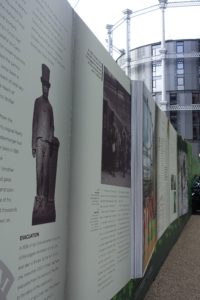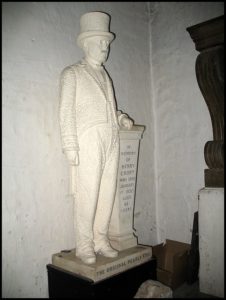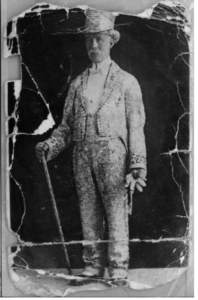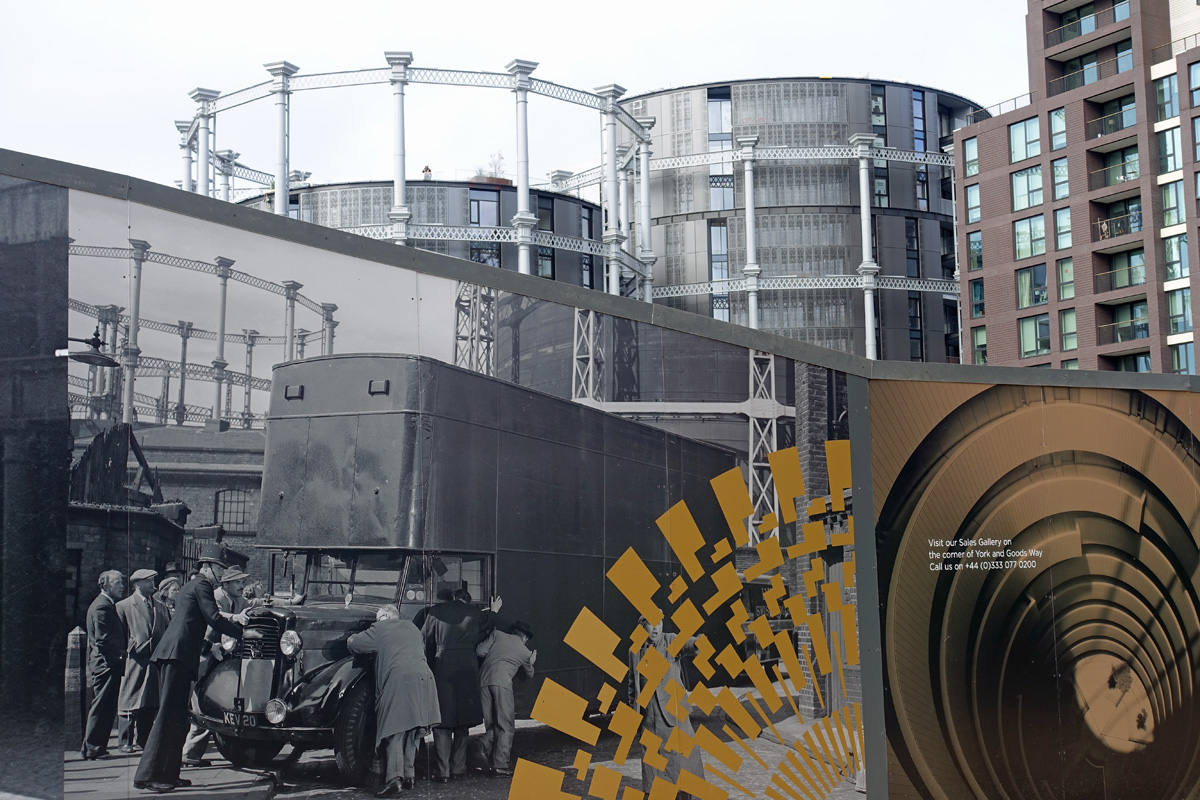The past decade has seen the rise of a vast property development in the King’s Cross district of central London. As its residential zone nears completion, Dr Philip Carter considers the life of Henry Croft – founder of the Pearly Kings, and a late-Victorian resident of King’s Cross – who features in the development’s marketing campaign. Recreating Henry’s life story owes much to a growing range of digitised resources now shaping microhistorical and prosopographical approaches to the past.
Step out of Senate House in Bloomsbury and you quickly encounter some exclusive real estate. Bedford, Russell, Gordon and Tavistock squares were among the most prestigious property developments of the late-18th and early 19th centuries, and their elegant terraces remain highly desirable. Keep walking from Tavistock Square and you come across their 21st-century equivalent, just north of King’s Cross station.
This huge development covers 67 acres and stretches from the station to Regent’s Canal and well beyond. It’s sufficiently large to merit its own postcode: N1C. The tech giant Google has moved into the development’s business zone. This is also the site of the company’s future ‘landscraper’; of King’s Place, home to The Guardian, and numerous bars and restaurants.
Cross the canal and you enter Granary Square with its entertaining fountains and high-end apartments in manicured grounds. At the centre of this new residential complex is ‘Gasholder Gardens’: four Victorian gasholders, restored and relocated, that serve as a reminder of the site’s industrial past. Three of the four structures now encase 145 apartments that start (for a studio) at £810,000. For an extra £2.75m you can get something bigger.
With this development comes a marketing campaign that draws inspiration from the gasholders, taking ‘heritage London’ as its theme. Billboards show photographs of helpful 1940s policemen and barrow boys going about their business in Austerity N1, as it then was. The aim, no doubt, is to give the new quarter a sense of community and charm. Most of the people who feature in this marketing are anonymous archetypes from an age of keeping calm and carrying on. But a handful of named individuals do appear. They include the 18th-century author Mary Wollstonecraft, who lived in nearby Somers Town, and another – lesser known – resident: Henry Croft (1861-1930), founder of the London Pearly Kings and Queens.
 Croft gets a few words on his advertising hoarding, along with a photo of his funeral statue (now at St Martin-in-the-Fields), showing him in a trademark pearly suit and top hat. A few years ago, and before the billboards, I became interested in Henry Croft and researched his then shadowy life, as well as the early decades of the Pearly movement. As a series of familial, social and charitable networks, Croft’s Pearlies continue to thrive across London today.
Croft gets a few words on his advertising hoarding, along with a photo of his funeral statue (now at St Martin-in-the-Fields), showing him in a trademark pearly suit and top hat. A few years ago, and before the billboards, I became interested in Henry Croft and researched his then shadowy life, as well as the early decades of the Pearly movement. As a series of familial, social and charitable networks, Croft’s Pearlies continue to thrive across London today.
There’s an irony, given his personal circumstances, that Henry’s now being used to promote luxury property. Croft was born in May 1861 at the St Pancras workhouse and spent his entire life in Somers Town, a working-class district bordered by King’s Cross and Euston stations. In 1892 he married Lily Newton, daughter of a Kentish Town handyman, and the couple had eight children, one of whom – John – was killed while serving in France in 1917. From the early 1890s the family lived at 15 Charles (now Phoenix) Street, just off Euston Road, in a shared 10-room tenement that’s long since disappeared.
For his entire adult life Croft worked as a road sweeper for St Pancras Borough Corporation, from which he retired in 1928. He died less than two years later, once more resident in the workhouse. In these details Henry’s life differed little from many of his neighbours, in a district shaped by the railway and its associated trades.
 Croft’s funeral, however, was not what you’d expect for a man of his social status. Held in January 1930, it attracted 400 mourners who processed from King’s Cross to the New St Pancras burial ground in East Finchley. His body was borne in a smart horse-drawn hearse, used 70 years later (at the singer’s request) for the funeral of Ian Dury. Funds were also raised for the statue, unveiled in 1934, which features in the marketing of the new King’s Cross development.
Croft’s funeral, however, was not what you’d expect for a man of his social status. Held in January 1930, it attracted 400 mourners who processed from King’s Cross to the New St Pancras burial ground in East Finchley. His body was borne in a smart horse-drawn hearse, used 70 years later (at the singer’s request) for the funeral of Ian Dury. Funds were also raised for the statue, unveiled in 1934, which features in the marketing of the new King’s Cross development.
The grandeur of Croft’s funeral – with its procession, pipe band, uniforms and banners – puts one in mind of state occasions held for royalty. It was even filmed by Pathé. But, of course, as the founder of the Pearly tradition, Henry was indeed royalty of a kind: the creator of his own successful regal dynasty, and known during his life as the ‘Original Pearly King’.
 Croft probably began making and dressing in suits covered with mother-of-pearl buttons in the mid-1880s. In doing so he created a fashion and an identity that drew on earlier traditions of misrule and sartorial inversion – as well as the ‘flash’ clothing of Victorian costermongers. The earliest newspaper image (left) I’ve found of Henry in costume dates from 1902. It shows the ‘Pearlie King of Somers Town’ dressed in a suit of 5,000 buttons. This was one of seven suits he created, along with pearly hats, belts, ties, and an overcoat of more than 30,000 buttons that weighed 25 kilograms.
Croft probably began making and dressing in suits covered with mother-of-pearl buttons in the mid-1880s. In doing so he created a fashion and an identity that drew on earlier traditions of misrule and sartorial inversion – as well as the ‘flash’ clothing of Victorian costermongers. The earliest newspaper image (left) I’ve found of Henry in costume dates from 1902. It shows the ‘Pearlie King of Somers Town’ dressed in a suit of 5,000 buttons. This was one of seven suits he created, along with pearly hats, belts, ties, and an overcoat of more than 30,000 buttons that weighed 25 kilograms.
In the 1890s and early 1900s the Pearlies became a London-wide network focused on social and charitable activity. It was said at his death that Croft’s ‘lifelong work for charity’ had raised £5,000 for good causes. By 1911 each of the capital’s boroughs boasted a pearly king, queen, and family – numbering about 300 individuals. Some drew on established local hierarchies of costermongers, though Croft himself was not involved in street trading. As the movement grew, its founder was celebrated as ‘King of the Pearlies’ and enjoyed a status that played on his identity as a monarch of the lower orders. In 1907, for example, Croft appeared at the Horse of the Year Show, Olympia, where he met Edward VII and Queen Alexandra.
Away from the limelight, broom and shovel in hand, Henry cleaned the streets walked daily by thousands of commuters and King’s Cross residents. Among them was Virginia Stephen (later Woolf) – Croft’s near neighbour and close contemporary – who’d moved, in 1904, to 46 Gordon Square in what was then a less salubrious Bloomsbury.
Members of the famous ‘Bloomsbury Circle’ began to gather at No. 46, and it was from here that Virginia, a committed pedestrian, set out for regular walks across the city. Woolf later moved to 52 Tavistock Square where she wrote To the Lighthouse which was published in the same year (1927) as one of her best-known essays, ‘The New Biography’. This essay is Woolf’s manifesto for a modern form of life writing that celebrates the hidden lives of ordinary people. ‘New biography’ was defined in opposition to an existing Victorian tradition of voluminous accounts of famous men. ‘Is not’, she argues, ‘anyone who has lived a life, and left a record of that life worthy of biography … the humble as well as the illustrious?’
By virtue of her famous family, clever friends and literary talent – as well as the millions of words written by and about her – Woolf was, and is, one of the ‘illustrious’. By virtue of being the ‘Original Pearly King’, her local road sweeper Henry Croft was likewise something of a celebrity – albeit minor and unusual. And yet, by his birth, residence and employment, Croft also remains one of ‘the humble’, an existence documented only in scattered public commentaries on his charitable works. Of his private life, scarcely anything remains: there are no diaries, memoirs, letters or household accounts.
Until recently, this was often the end of the story. But this is no longer the case for the first Pearly King. That we now have for Croft what Woolf called ‘a record of that life worthy of biography’ owes much to a remarkable growth in the range of digitised sources charting the past. As never before, these records are making available the personal details of hundreds of thousands of previously hidden or ‘humble’ individuals.
In the UK these sources include (to name just a selection) the census returns from 1841 to 1911; registers of births, marriages, and deaths for England, Wales and Scotland; as well as parish registers for earlier periods. There are also digitised electoral registers, poll books, telephone directories, ships’ passenger lists; criminal registers and prison records; medical and nursing registers; military service and medal files; copies of wills held at The National Archives; and probate records from the 1860s onwards.
From records like these, with some trial and error, the details of Henry Croft’s story, and those of his family, can now be assembled. Other digital resources have set their lives in greater context. The latest version of Charles Booth’s London poverty maps, for instance, includes the police notebooks on which Booth’s famous survey was based. These allow us to zoom in on the King’s Cross where Henry Croft lived and worked – often to the level of an individual house. Charles Street, where Henry spent much of his life, was described in 1898 as ‘good working-class’, while nearby Chalton and Ossulton streets, home to a ‘poor population’, were ‘on the whole rather “rough”’.
In addition to these biographical records (of which, by 2015, Ancestry.com had digitised an estimated 18 billion) are millions of pages of national and regional newspapers, published between the 17th and 19th century, as well as selected national newspapers into the early 21st century. From these it’s possible to trace the scattered public appearances of the Original Pearly King, and his growing charitable network in Edwardian London.
The positive (and negative) impact of digital resources like these is now hotly contested by historians. To date, much of this focus (provocatively so in Jo Guldi and David Armitage’s History Manifesto) has been on digital’s contribution to ‘big histories’ of large data sets and greater chronological and geographical scale. But as Henry Croft reminds us, digital also has considerable potential for biographical, affective and microhistorical approaches to the past along with histories of working-class life, of a richness and intricacy that was previously much harder to assemble.
By making discoverable the partial and scattered details of men like Croft, digital resources afford connections that bring many more of Woolf’s ‘humble’ lives into view. In this Henry is not exceptional. Rather, he’s one of many historical figures who catch our attention with a fleeting appearance in public documents. Rarer but increasingly possible is the opportunity to recreate such episodes as biography, and to connect these biographies, historically and digitally, to further recovered lives.
Other connections are more tangible and of the moment. Completion of Gasholder Gardens this summer coincides with the opening of a new ‘Somers Town Bridge’. Spanning Regent’s Canal, the bridge links the King’s Cross of the 2010s, where Henry Croft helps sell apartments and evoke community, to that of the 1910s: swept and ruled over by a pearly king of the Cross.
Dr Philip Carter is senior lecturer and head of IHR Digital at the Institute of Historical Research. A fuller account of Henry Croft (1861-1930) appears in the Oxford Dictionary of National Biography online.

